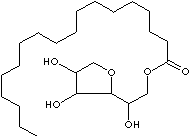Sorbitan
- (3S ) -2 - ( 1,2- dihydroxyethyl ) oxolane -3 ,4- diol
- (3S ) -2 - ( 1,2- dihydroxyethyl ) tetrahydrofuran -3 ,4 -diol
Solid, usually obtained as a dark colored oil or syrup to
Solid or liquid
111-112 ° C
Soluble in water, methanol, ethanol, isopropanol
Template: Infobox chemical / molecular formula search available
Sorbitan (short for sorbitol anhydride, and anhydrosorbitol ) is a mixture of isomeric compounds selected from the chemical group of heterocycles and polyols. The mixture is formed in the elimination of a molecule of water from sorbitol ( in the English literature called sorbitol ) and consists mainly of 1,4- D- sorbitol anhydride - a five-membered cyclic (, furanoid ') ether - in addition to the isomeric 2,5 - furanoid anhydrosorbitol and the isomeric 1,5 - pyranoid anhydrosorbitol. The elimination of another molecule of water leads to isosorbide ( 1,4:3,6 - dianhydro -D-sorbitol )
Production and representation
Sorbitan formed by mono-molecular dehydration of D- sorbitol together with other isomers of the anhydro - sorbitol, mannitol and Iditolreihe. The elimination of water occurs from about 120 ° C under acid catalysis by mineral acids, acidic ion exchangers or supported heteropolyacids at normal pressure, under vacuum or in supercritical water. In mild reaction conditions, the 1,4- anhydride is preferably formed. Under harsher reaction conditions, it comes under dimolekularer dehydration to form isosorbide or by intermolecular elimination of water to form oligomers and polymers.
In most cases the resulting Sorbitangemisch is not isolated or even separated into the individual anhydrosugars but processed directly to isosorbide or sorbitan esters.
Properties
1,4-sorbitan is described in the literature after decolorization and recrystallization from isopropanol (colorless ) solid with melting point 111-112 ° C. In industrial syntheses, the isomer mixture is obtained as a dark colored oil. Sorbitan dissolves in water and lower alcohols.
Use
1,4-sorbitan as the starting material used for isosorbide and sorbitan fatty acid esters, which are among the lipophilic non- ionic surfactants. Because of their high surface activity, see sorbitan fatty acid esters ( sold under the trade name Span ) uses as biodegradable emulsifiers, solubilizers and stabilizers in cosmetic and pharmaceutical preparations as a non-toxic formulation aids in a variety of applications of coatings to cleaning, plant protection and food, as well as temperature and UV -stable plasticizers for PVC.
By reaction with ethylene oxide resulting from the chip, the corresponding ethoxylated sorbitan fatty acid esters, which are a class of hydrophilic non- ionic emulsifiers under the trade name Tween.










